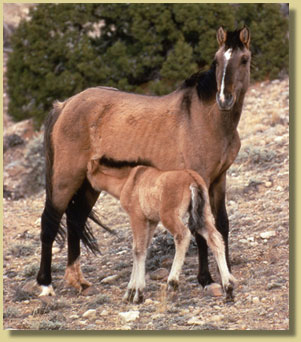
Big Horn Herd Area
Be an effective advocate
Being an "Advocate" is a unique responsibility to the Wild Horse & Burro program. To present oneself in front of an Advisory Board, any public meeting or to write a pragmatic comment requires one to be educated about the issues, and the program itself. I will outline a basic learning outline for all to experience for themselves at their own pace. All of the information is available online, with a good share on this website's Education pages.
As wild horse and burro advocates, you’ll be responding to EA and EIS documents during public comment periods and in public speaking engagements. To be successful in your response, advocates must learn to both write pragmatic comments and to speak effectively in front of boards and groups. As well incorporate your new writing skills into your speech writing techniques and always include scientific evidence from the literature on your topic. If one is to disagree with any BLM management principle or a motion by EA or EIS to round up wild horses or burro’s then offer an alternative solution in your defense. You can call the district BLM office in each state to request the location of documents. It's on your shoulders as a dedicated advocate as wild horse and burro advocates to feel confident in your new endeavor with the tools available on our website. Your words will become the swords of truth and justice and demand the respect of your peers to support the Wild Horse and Burro program, and more importantly defend these animals knowing you have made a difference.
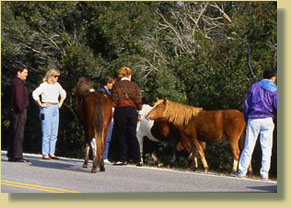
Tourists at Chincoteague Island
Nat. Wildlife Refuge, Virginia
The following topics will need to be researched and understood and are available through our hyperlinks below:
• The Federal Land Policy and Management Act of 1976
• Public Land History with grazing issues
• The Wild Free-Roaming Horses and Burros Act of 1971 (PUBLIC LAW 92-195)
• EA and EIS documents
• Wild Horse Legislation
• Wild Horses as Native American Wildlife (PDF)
• PZP, Q&A analysis (PDF)
• Code of Federal Regulations, subpart 4700
• National Environmental Policy Act (NEPA) (EA & EIS)
• Wild Horse Time Line
• Management on the Range
• Wild Horse & Burro Planning
• Wild Horse & Burro Program guide
• BLM's "Organic Act"
In 1978, The Public Rangelands Improvement Act (PRIA) was enacted and is one of the more influential pieces of legislation to the Wild Horse and Burro Act of 1971 (WFRHBA). In essence it stressed the multiple use concept and included the words excess, overpopulation and removal are now included into the language of the 1971 Act. In layman's terms it implies the removal of horses and burros can be made to maintain the thriving ecological balance that would protect the range from deterioration as associated with their overpopulation.
In a Federal Appeals Court decision, AHPA v. Watt, now serves as a precedent in all court cases to follow, DC Circuit (694 F.2d 1310, 224 U.S.App.D.C. 335): In summary main thrust of the 1978 amendments is to cut back on the protection the Act affords wild horses, and to reemphasize other uses of the natural resources wild horses consume. The amendments introduce a definition of “excess” horses: and if horses are in “excess” they must be removed from an HMA herd area in order to preserve and maintain a thriving natural ecological balance and multiple-use relationship in that location,” *1317**342 16 U.S.C. § 1332(f) (Supp.IV 1980).FN30 This definition makes explicit what was, at most, implicit in the 1971 Act: public ranges are to be managed for multiple uses, not merely for the maximum protection of wild horses. In concern, I contacted attorney Laura Allen and asked for an interview to research these important concerns regarding what really was changed by the amendment process of both, The Federal Land Policy and Management Act of 1976 (FLMPA) and The Public Rangeland Improvement Act of 1971 (PRIA).
Organizations
America's Wild Horse Advocates
AWHA P.O. Box 156 Blue Diamond, Nevada 89004
www.awha.info/index.htm
Alliance of Wild Horse Advocates
4820 Allamar Boise, ID 83704 (208-375-1384)
www.aowha.org
Willis Lamm - willis@kbrhorse.net
American Horse Defense Fund
1718 M Street, N.W. Unit 191
Washington, DC 20036-4504
www.ahdf.org
President@AHDF.org
American Mustang & Burro Association, Inc.
P.O. Box 788, Lincoln, CA 95648
(916) 633-9721
www.ambainc.net
Animals' Angels
P.O. Box 1056; Westminster, MD 21158
www.animals-angels.com
info@animals-angels.com
ASPCA
424 E. 92nd St., New York, NY 10128-6804
www.aspca.org
lobby@aspca.org
Bureau Of Land Management/ National Wild Horse & Burro Program Office
850 Harvard Way, P.O. Box 12000, Reno, NV 89520-0006
www.blm.gov/wo/st/en.html
The Cloud Foundation
107 S. 7th St.; Colorado Springs, CO 80905
www.thecloudfoundation.org
makendra@thecloudfoundation.org
Corolla Wild Horse Fund of Outer Banks
P.O. Box 361, Corolla, NC 27927
www.corollawildhorses.com
DreamCatcher Wild Horse and Burro Sanctuary
mustangsb@hughes.net
www.greenpeople.org/listing/DreamCatcher-Wild-22119.cfm
Equine Advocates
P.O. Box 354, Chatham, NY 12037-0354
www.equineadvocates.org
Equine Welfare Alliance
ewa@equinewelfarealliance.org
www.equinewelfarealliance.org
Friends of the Mustangs
c/o Judy Cady, 2131 L- 1/2 Road, Grand Junction, CO 81505
http://friendsofthemustangs.org
Habitat for Horses, Inc.
P.O. Box 213; Hitchcock, TX 77563
office@habitatforhorses.org
www.habitatforhorses.org
Helping Hearts Equine Rescue, Inc.
P.O. Box 342; Perrineville, NJ 08535
http://hher.webs.com/
hheartsequine@optonline.net
Horse Rescue, Relief and Retirement Fund, Inc.
1768 Newt Green Rd.; Cumming, Georgia 30040
www.savethehorses.org
Horseback Magazine
donna@horsebackmagazine.com
International Society for the Protection of Mustangs & Burros (ISPMB)
6212 East Sweetwater Avenue, Scottsdale, AZ 85254 (602-991-0273)
www.ispmb.org
Journey's End Ranch Animal Sanctuary
8746 N. Stockton Hill Rd. PMC #18; Kingman, AZ 86409
www.jersanctuary.org
JERAnimalSanctuary@frontier.com
Madeleine Pickens - Help Save America’s Wild Horses
www.madeleinepickens.com
Manes and Tails Organization
www.manesandtailsorganization.org
info@manesandtailsorganization.org
National Mustang Association, Inc.
1st and Main Steets, Newcastle, UT 84756 (801-439-5440)
www.nmautah.org
National Wild Horse Association
P.O. Box 12207, Las Vegas, NV 89112 (702-452-5853)
www.nwha.us/about.htm
National Wild Horse, Burro & Animal Sanctuary
Attn: Ranch Manager, P.O. Box 65, North San Juan, CA 95960 (530-292-3090)
info@wildhorseburroanimalsanctuary.com
Old Friends Equine
1841 Paynes Depot Road; Georgetown, KY 40324
www.oldfriendsequine.org
Rainbow Meadows Rescue and Retirement, Inc.
karen.everhart@rainbowmeadowsranch.com
Redwings Horse Sanctuary
info@redwingshorsesanctuary.org
http://redwingshorsesanctuary.org
Return to Freedom
P.O. Box 926, Lompoc, CA 93438
www.returntofreedom.org
admin@returntofreedom.org
Sacred Heart Equine Rescue
18903 W. Culver St.; Buckeye, AZ 85326
sacredheartequinerescue@yahoo.com
www.sacredheartrescue.com/Links.html
Saving Horses, Inc.
8840 Hunter Pass; Alpine, CA 91901
www.savinghorsesinc.com
Saving Our American Wild Horse
info@saveourwildhorse.com
www.theamericanwildhorse.com/archives.html
Second Chance Ranch
288 North Main; Veyo, UT 84782
buckoland@yahoo.com
www.secondchanceranch.org/otherresources.htm
Spring Farm CARES Animal Sanctuary
information@springfarmcares.org
www.springfarmcares.org
Steens Mountain Kiger Registry
26450 Horsell, Bend, OR 97701 (541-477-2676)
www.kigers.com/smkr/info.html
Triple H Miniature Horse Rescue
Steve and Alison Smith; PO Box 4125; Bismarck, ND 58502
www.hhhmhr.org
Tri-State Mustang Club
RRI, Box 180, Hayfield, MN 55940 (507-477-2676)
www.tristatemustang.com/history.htm
Whispering Winds Equine Rescue
whisperingwindsequinerescue@msn.com
www.whisperingwindsequinerescue.com
Wild Hoofbeats
Carol Walker: 16500 N. Dakota Ridge Road; Longmont, CO 80503
cw@livingimagescjw.com
Wild Burro Rescue & Preservation Project
P.O. Box 10, Olancha, CA 93549-0010
www.wbrpp.com
Wild Hearts horse fund
www.wildheartshorsefund.org
shiftover@rogers.com
back to top -Organizations
Books
Berger, Joel. Wild Horses of the Great Basin Social Competition and Population Size. Chicago: The University of Chicago Press - 1986
Curtain, Sharon - Eastcott, John - Momatiuk, Yva. Mustang. Rufus Publications, Inc. - 1996
Dobie, Frank J. The Mustangs. University of Texas Press
Eustin-Cross, Barbara, and Bowker, Nancy. The Wild Horse: An Adopters Manual. New York: Macmillan - 1992
Hairbury, Martin. The Last of the Wild Horses. Doubleday & Company, Inc -1984
Hansen, Skylar. Roaming Free Wild Horses of the American West. Northland Press
Kirpatrick, Jay. Into the Wind. Norwood Press - 1994
Olke, Hardy. Born Survivors on the Eve of Extinction. Premier Publishing
Purcell, Edward. Wild Horses of America. Portland House
Roever, J. M. and Wilfred. The Mustangs. Austin, TX: Steck - Vaughn -1971
Ryden, Hope. Americas Last Wild Horses, rev. ed. New York: Lyons & Burford -1990
Ryden, Hope. Mustangs, A Return to the Wild. Mountain Press Publishing Co.
Walker, Wyman D. The Wild Horses of the West. University of Nebraska Press
back to top
Pamphlets
"Managing for Extinction, Shortcomings of the Bureau of Land Management's Wild Horse and Burro Program," Washington D.C., Doris Day Animal League, c/o Liz Clancy Lyons, 2000
back to top
Articles
Williams, Wendy. "The Horse Rustlers." Animal May/June 1998, pp. 10-15
Coates-Markle, Linda. "Choosing to Survive." Equus January 1997, pp. 34-41
Berger, Joel. "Funding Asymmetries for Endangered Species, Feral Animals, and Livestock." BioScience February 1991, pp. 105-106
Foote, Donna. "Death of the Range." Newsweek July 22, 1991, p. 25
"No Longer Home on the Open Range." U.S. News and World Report June 13, 1988, pp. 57-58
Symanski, Richard. "America's Wild Horses." Focus Fall 196, pp. 20-28
Tennesen, Michael. "Reining in a Runaway Herd." National Wildlife October/November 1992, pp. 22-25
"Wild Horse Refuge." Encyclopedia Science Supplement 1993 New York: Franklin Watts, 1992, pp. 291-296
Willianson, Lonnie. "Out of Range." Outdoor Life April 1992, pp. 96-98
back to top
Internet Resources
Bureau of Land Management (Official National Wild Horse and Burro Site)
back to top
Can the Wild Horses and Burros be Saved?
Note from the Director of the WindDancer Foundation: I took this question up with Laura Allen of “Animal Law Coalition” and this is our conversation.
Laura Allen, Esq. is the founder and Executive Director of Animal Law Coalition which advocates for the rights of animals to live and live free of cruelty and neglect. Laura Allen is a trial attorney with more than 20 years of experience trying cases and arguing appeals in the state and federal courts in Washington, Illinois, Missouri and Arizona. She is a member of the bar of the U.S. Supreme Court.
WindDancer: There is an ongoing controversy regarding the interpretation of those management protections affecting the Wild Horse and Burro act from FLMPA (1976) and PRIA (1978) amendments. In 1971 the Wild Free Roaming Horses and Burros Act (WFRHBA) was passed to provide broad protections for wild horses and burros on public lands. The law states that “wild free-roaming horses and burros are living symbols of the historic and pioneer spirit of the West...[T]hey contribute to the diversity of life forms within the Nation and enrich the lives of the American people”. 16 U.S.C. §1331 et seq. Congress recognized the wild horses and burros are “fast disappearing from the American scene”. 16 U.S.C. §1331 et seq
WindDancer: What are the legal protections for wild horses and burros on our public lands?
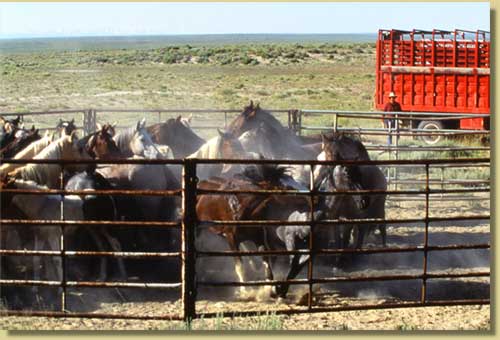
Rock Springs round-up
Laura Allen: Wild horses and burros are supposed to be treated as “components of the public lands”. 16 U.S.C. § 1333(a) The law is clear that “wild free-roaming horses and burros shall be protected from capture, branding, harassment, or death” and entitled to roam free on public lands where they were living at the time the Act was passed in 1971. 16 U.S.C. § 1331 These legally protected areas are known as “herd areas,” and are defined as “the geographic area identified as having been used by a herd as its habitat in 1971.” 43 C.F.R. § 4700.0-5(d).
The WFRHBA also authorizes designation of specific ranges for wild horses and burros. “‘Range’ means the amount of land necessary to sustain an existing herd or herds ...and which is devoted principally but not necessarily exclusively to their welfare in keeping with the multiple-use management concept for the public lands”. 16 USCS §§ 1332(c), 1333(a).
Though “excess” wild horses and burros are to be removed, in general, “[m]anagement activities affecting wild horses and burros shall be undertaken with the goal of maintaining free-roaming behavior.” 16 U.S.C. §1333, 43 CFR 4700.0-6 “All management activities shall be at the minimal feasible level”. 16 U.S.C. §1333(a) It is illegal to maliciously or negligently injure or harass wild horses or burros protected by the Act, treat them inhumanely or use them for commercial gain. 43 CFR §4770.1
The Bureau of Land Management is the agency within the Department of Interior that is responsible for enforcing the WFRHBA. According to WFRHBA and its own regulations, BLM must protect wild horses and burros from unauthorized capture, branding, harassment or death and provide these animals with humane care and treatment. 43 C.F.R. § 4700. “Humane treatment means handling compatible with animal husbandry practices accepted in the veterinary community, without causing unnecessary stress or suffering to a wild horse or burro.” 43 CFR 4700.0-5(e)
The BLM is directed to protect the wild horses and burros “in a manner that is designed to achieve and maintain a thriving natural ecological balance on the public lands” and “protect the natural ecological balance of all wildlife species which inhabit such lands, particularly endangered wildlife species. Any adjustments in forage allocations on any such lands shall take into consideration the needs of other wildlife species which inhabit such lands.” 16 U.S.C. §1333(a). The Public Rangelands Improvement Act of 1978 amended the WFRHBA to require BLM to determine appropriate management levels (AML) and maintain an inventory of wild horses and burros to help achieve these goals.
The amendment also addressed “excess” horses defined to mean wild horses and burros to be removed from an area “to preserve and maintain a thriving natural ecological balance and multiple-use relationship in that area” or for some other legal reason. See 16 USC §1332(f). The WFRHBA says that before removing wild horses and burros, a determination must be made that there is an overpopulation and removal is indicated “so as to restore a thriving natural ecological balance to the range, and protect the range from the deterioration associated with overpopulation”. 16 U.S.C. §1333(b)(2)
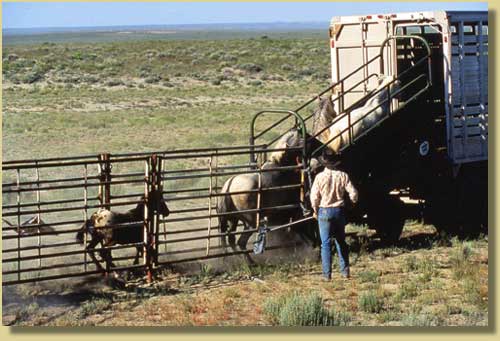
Rock Springs round-up
WindDancer: Can you explain the multiple use concept beyond the plain language of WFRHBA for my readers?
Laura Allen: The BLM has interpreted the WFRHBA to mean it can "manage" wild horses and burros with the goal of allowing multiple uses on all public lands including the herd areas. But, though the statute mentions "multiple-use relationship" in connection with specified ranges, it is very clear that the directive is to manage these animals otherwise only to "maintain a thriving natural ecological balance on the public lands" and "protect the natural ecological balance of all wildlife species which inhabit such lands, particularly endangered wildlife species."
In effect, WFRHBA authorizes only limited interference with wild horses and burros in herd areas where they were living in 1971. Nothing about removing wild horses and burros from herd areas where they lived in 1971 to allow multiple use such as cattle grazing, recreation for off road vehicles, mining or development. Also, protecting the ecological balance of all wildlife has never meant rounding up and removing whole species. Especially when there is a law that explicitly protects their right to exist in historic herd areas.
Even designated ranges managed under a multiple use concept are to be "devoted principally" to wild horses and burros. The wild horses and burros on these lands are not to be eliminated for cattle or mining or recreation or even secondary to these other uses.
Despite the limited authority to interfere with wild horses and burros under WFRHBA, the BLM has decided, however, the multiple public use concept applies to all herd areas as well as ranges. BLM even issued a regulation that effectively rewrites WFRHBA to say the "objectives of these regulations are management of wild horses and burros as an integral part of the natural system of the public lands under the principle of multiple use". 43 CFR § 4700.0-2 Yet, the WFRHBA says only that wild horses and burros "are to be considered in the area where presently found, as an integral part of the natural system of the public lands". 16 U.S.C. §1331.
WindDancer: Explain the authority of the BLM to integrate the Herd Areas (HA) into the “herd management areas” under the WFRBA?
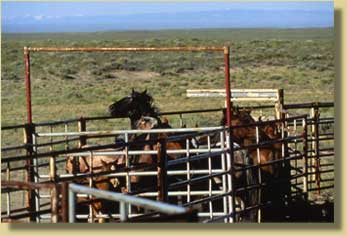
Rock Springs round-up
Laura Allen: The BLM has authorized itself to divide herd areas into "herd management areas", something not authorized by WFRHBA. 43 CFR 4710.3-1. In this way, with no statutory authority at all, BLM has limited wild horses and burros' access to thousands of acres that were historically their herd areas. This is done without thought about the horses' seasonal migration patterns or available resources. The BLM then removes wild horses and burros from the artificially created "herd management areas" on the basis there is insufficient forage, water or habitat! BLM also targets them for removal if they cross the artificial boundaries into their original herd areas.
While BLM has authorized itself to create divide herd areas into Herd Management Areas, its own regulations provide that "management of wild horses and burros shall be undertaken with the objective of limiting the animals' distribution to herd areas, 43 C.F.R. § 4710.4."Herd area" is defined by regulation as "the geographic area identified as having been used by a herd as its habitat in 1971," 43 C.F.R. §4710.4.
WindDancer: Does WFRHBA or FLPMA authorize the BLM’s multiple use concept for all herd areas?
Laura Allen: Another example of BLM's erosion of the WFRHBA protections is the rewording of the WFRHBA mandate "[a]ll management activities shall be at the minimal feasible level". BLM's regulation says "[m]anagement shall be at the minimum level necessary to attain the objectives identified in approved land use plans and herd management area plans." 43 CFR 4710.4, 16 U.S.C. §1333. Two very different laws. So if a land use plan authorizes a land giveaway or increased recreation or mining, "management...at a minimum level" can mean round up and removal, according to the BLM.
The BLM's job is undoubtedly complicated by the mandate of the Federal Land Policy Management Act, which requires management of public lands under concepts of multiple use and sustained yield. 43 U.S.C. §§ 1701, et seq. But the multiple use concept does not trump the WFRHBA protections for wild horses. In fact, the statute makes clear that the protections under WFRHBA take precedence. FLPMA, 43 U.S.C. § 1732 (a) Yet, despite this, BLM has issued a regulation that provides "[w]ild horses and burros shall be considered comparably with other resource values in the formulation of land use plans." 43 C.F.R. §4700.0-6(b).
The BLM's land use plans make clear that contrary to WFRHBA, it does not decide to remove wild horses and burros only to maintain a "thriving natural ecological balance to the range, and protect the range from the deterioration associated with overpopulation". Nor are the protected wild horse ranges "devoted principally" to the use of wild horses and burros. Instead, the BLM clearly embraces the multiple use concept for all lands designated for wild horses and burros. Indeed, the plan seems to be to eliminate or zero out the wild horses and burros in favor of increased development and recreational use, mining, and cattle.
WindDancer: I would like you to outline some background information on the legal protections for wild horses and burros?
Laura Allen: Just this past month a federal court in Colorado Wild Horse and Burro Coalition, Inc. v. Salazar, No. 06-1609 (D.D.C 2009), shut down BLM's efforts to assert even more power over the wild horses and burros. The BLM maintained it had the discretion to remove an entire herd of horses even if they were not "excess". The Court determined, to wit:
'[t]he principal problem in maintaining wild horses in the West Douglas Herd Area is a major shift in wild horse grazing use patterns that has occurred since the early 1980's. ...It is probable that intense energy exploration and development occurring in the northern part of the herd area has concentrated use in the south....This change of use has resulted in overgrazing the Texas Creek drainage, and horse use in Missouri and Evacuation Creeks that are not a part of the 1971 herd area.... Accordingly, it is this shift in the West Douglas Herd's grazing patterns, likely caused by human development, and not overpopulation, that formed the basis for BLM's decision to remove the West Douglas Herd.'
The Court concluded, to wit:
It would be anomalous to infer that by authorizing the custodian of the wild free roaming horses and burros to "manage" them, Congress intended to permit the animals' custodian to subvert the primary policy of the statute by capturing and removing from the wild the very animals that Congress sought to protect from being captured and removed from the wild.
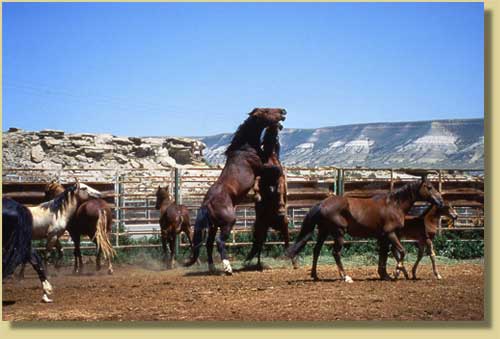
Rock Springs round-up
Defendants argue that the horses will not be "eradicated" or "eliminated" inasmuch as BLM intends to continue to manage the horses not in the wild but through private adoption or long-term care. ...But BLM's directive is "to protect and manage wild free-roaming horses and burros as components of the public lands . . . ." 16 U.S.C. § 1333(a) (emphasis added). Congress did not authorize BLM to "manage" the wild horses by corralling them for private maintenance or long-term care as non-wild free-roaming animals off of the public lands.
Upon removal for private adoption and/or long-term care, the West Douglas Herd would forever cease to be "wild free-roaming" horses "as components of the public lands" contrary to Congress's intent to protect the horses from capture.
Moreover, the statute expressly provides that BLM's "management activities shall be at the minimal feasible level . . . ." It is difficult to think of a "management activity" that is farther from a "minimal feasible level" than removal.

Rock Springs round-up
WindDancer: It seems the goal now is for BLM managers of the wild horse and burro herds are now focused on removing them from public lands?
Laura Allen: From 1971 through 2007, over 267,000 wild horses and burros were removed from their homes by BLM. In 2001, BLM stepped up removals. According to the Government Accountability Office, "[s]ince then, about 10,600 animals have been removed, on average, per year." Just since 2001 the BLM has removed over 74,000 wild horses and burros. "BLM has reduced the nationwide population in the wild by about 40 percent since 2000."
The BLM was filling holding pens with few prospective adopters until Sen. Harry Reid (D-NV) convinced then Sen. Conrad Burns (R-MT) to push through an amendment to the WFRHBA in 2004. The Burns Amendment was buried in an appropriations bill that was thousands of pages long. It authorizes BLM to sell excess wild horses that are "more than 10 years of age; or ... [which have] been offered unsuccessfully for adoption at least 3 times." 16 U.S.C. §1333. Any horse sold under this provision is no longer subject to the protections of the Wild Free-Roaming Horses and Burros Act. 16 U.S.C.§1333. Since this amendment became effective, BLM has sold thousands of wild horses for slaughter. More room in the holding pens for more horses and burros.
As of February 2008, the estimated on the range population of wild horses and burros was 33,105. As of June 2008, the number of these animals in short-term holding was 7,987, and 22,101 were in long-term holding. This according to the GAO which relies on BLM figures.
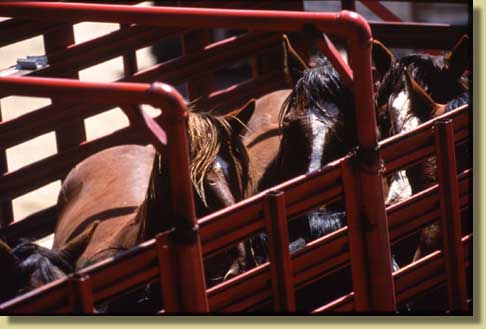
Rock Springs round-up
It is an understatement to say BLM does not manage the wild horses and burros to maintain "free-roaming behavior." Instead, BLM has devastated herds and families and terrified and injured thousands of horses and burros rounded up by helicopters and run into holding pens. Incredibly, at least one contractor hired often by BLM to run down and remove wild horses and burros has a criminal record, convicted of using a helicopter to run down and steal wild horses from their homes on public lands and selling them for slaughter!
BLM has worked to clear public lands of wild horses and burros, and most of its efforts in regard to these animals are concentrated on keeping them in holding pens or moving them to slaughter. The budget numbers bear this out. According to the GAO, the "percentage of the ... direct costs for holding animals off the range increased from $7 million in 2000 (46 percent) to $21 million in 2007 (67 percent)" and in 2008 costs for holding animals was expected to account for up to 74 percent of the Wild Horse and Burro program's budget.
The wild horses and burros get notoriously poor care in holding pens. They languish and die of illness, injuries and broken spirits and hearts.
WindDancer: How does the BLM justify the removals?
Laura Allen: The BLM is required by National Environmental Policy Act ("NEPA"), 42 U.S.C. §§ 4321, et seq., to prepare Environmental Assessments or EAs or, if indicated, Environmental Impact Statements (EIS) or Finding of No Significant Impact (FONSI), for any proposed changes to public lands that may have a significant environmental impact. The law directs the agency to identify environmental concerns, consider alternatives including no action at all and take a "hard look" at the problem and minimize significant environmental impact. A significant environmental impact includes actions that are likely to be highly controversial or have uncertain effects on the quality of our lives and that affect cultural and historical resources. 40 C.F.R. §1508.27(b).
These evaluations as well as land use plans are full of words but have little substance when it comes to stating why wild horses must be removed from their homes. It is what is not in these documents that is telling.
For example, the BLM recently reduced the Pryor Mountain herd known as Cloud's Herd on a specified range in Montana from an estimated 190 to 120 horses. Yet, equine geneticist, Gus Cothran, Ph.D. of Texas A&M University, states that "a census population of 150-200 is required to achieve the minimum effective population size". The EA justifying the decimation of this herd spoke vaguely about limited water, "competition among wild horses and wildlife" presumably for food, and "deterioration of rangelands and vegetation resources".
But, according to Cloud Foundation, there has been 3 years of rainfall that has ended the drought and left the range in "excellent condition". The horses removed from the herd certainly looked well fed and hydrated.
Instead of managing the wild horses to maintain "free roaming behavior", BLM has left Cloud's herd devastated, injured and genetically nonviable.
WindDancer: Is is true in the BLM’s plans, and under way now, to zero out or eliminate 12 herds in Lincoln and Nye Counties in Nevada?
Laura Allen: In a recent assessment the BLM estimated there were 1,357.43 acres per wild horse in one herd area, about 350 horses; and 3,377.38 acres per horse in another herd area, about 270 horses. The BLM is in the process of zeroing out all of these herd areas, known as the Seaman including Golden Gate, and White River Herd Area and the Caliente Herd Area. Not one wild horse will be allowed to live anywhere in these herd areas despite that in 1971 they were designated for the wild horses and burros.
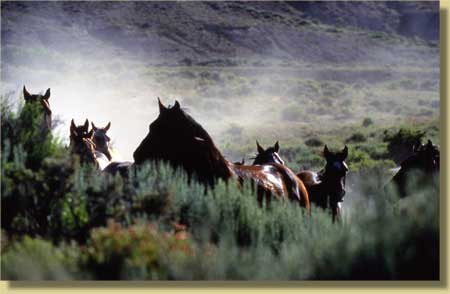
Rock Springs round-up
The BLM made an announcement on May 26, 2009 of its intention to eliminate the Seaman (including Golden Gate) and White River herds and on June 11, 2009 of the plan to eliminate the Caliente herds. Then, on August 14, 2009 BLM issued its Decision Record (DR) and Finding Of No Significant Impact (FONSI) which was tiered to BLM's Ely Proposed Resource Management Plan/Final Environmental Impact Statement (RMP/EIS, 2007) released in November 2007, in which BLM decided to eliminate the Seaman and White River Herd Management Area and zero out or eliminate all wild horses despite the protections of the WFRHBA. This decision was finalized in August, 2008, in BLM's Ely District Record of Decision and Approved Resource Management Plan.
The reasons for these removals, as reported in both EA‘s, issued on May 26 and June 11, are generally described as "range deterioration" and an alleged "shortage of water" resources. The BLM's 2007 Ely Proposed Resource Management Plan/Final Environmental Impact Statement did not mention the Caliente Herds and offered no evaluation for the determination the Seaman (Golden Gate) and White River herds lack sufficient water and forage and reproductive viability or that the Seaman herds have inadequate summer habitat and cover.
The BLM also did not consider the contribution of cattle, sheep or large game or off road vehicles to trampling and other "range deterioration", if any, or their use of water. The BLM has issued grazing permits that allow thousands of cattle and sheep to graze in these herd areas. Cows drink 30 gallons of water a day, and cattle as well as sheep trample and foul waters.
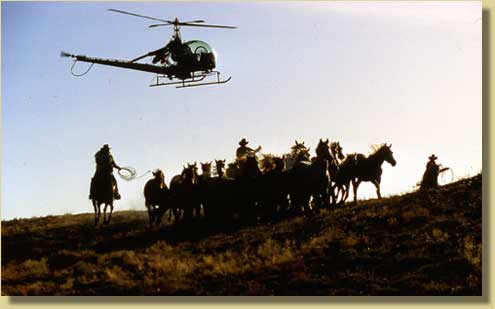
Rock Springs round-up
BLM never considered re-drawing the artificial "Herd Management Area" boundaries to include other water sources. The BLM never considered running wells or bringing in water during peak grazing times.
BLM never took a "hard look" as required by NEPA at the environmental impact of thousands of livestock occupying the same lands as wild horses and burros and other wildlife, the disruption and displacement that may cause to the horses and other wildlife, or alternatives to wholesale removal of the horses.
Curiously, on July 17, 2009 BLM issued an evaluation assessment in connection with renewal of a grazing permit for certain allotments that included portions of these same wild horse areas.
In this EA regarding renewal of the grazing permit, BLM stated that allotments that included the overlapping wild horses herd management areas "were making significant progress" towards attaining the rangeland health standards. (The Rangeland Health Standards are used by BLM to determine the health of the land.)
Apparently, the BLM prepares EAs or EIS depending on its goal. The range is deteriorating and without water when the agency wants to remove wild horses and burros. It is healthy when BLM wants to renew grazing permits.
Indeed, a local veterinarian told the BLM:
"habitat conditions [in the herd areas] appear so lush...On my drive [through the White River herd area in the summer, 2009], the ground conditions were breathtakingly beautiful, with greenness, sprouting new vegetation, and lushness. ...[T]hese conditions represented a remarkably comfortable-looking environment for wild horses which live in that Herd Area.
"I saw fewer than a dozen wild horses during the 30-mile drive, and the road contained very little in the way of horse droppings..... I did not observe any "trailing" areas, or areas where "excessive utilization" might be said to occur, since this area looks marvelous....
"I note that the BLM claims an absence of water as a primary reason for horse removal. Yet, it appears that in the last 10 years, close to 700 horses were removed from the White River Herd Area, and the current census of animals is estimated at a very modest 168 animals. Clearly, there is water available for that Herd Area. If the BLM doesn't know where it is, the horses apparently do, since they have been successful in living on that very large Herd Area for years....
"I send this letter, then, with a large question for myself as to why horse removal is necessary ....Vegetation conditions now are remarkably good, and the large size of the Herd Area compared to the small number of horses estimated to be in attendance, does not warrant horse removal based upon current conditions in my view....
"I would wonder if this planned horse removal is nothing more than a politically-inspired action rather than something related to on-the-ground conditions since my admittedly brief look at the center of the Horse Area would not suggest need for a zeroing out of horses in that area at this time."
A wildlife ecologist who has studied Nevada's wild horses and burros extensively since the 1960s, toured the targeted Seaman and White River and Caliente herd areas this past August, 2009, immediately prior to the removals. He noted few wild horses and saw no reason the BLM could not provide any resources these few horses might need. He emphasized the importance of the wild horses to the ecological balance especially given that they are better suited to digesting coarse dry vegetation than cattle, sheep, elk, and deer. Horses, unlike other animals, are better at ferreting out remote water sources and even prolonging them for use by other species.
The wildlife ecologist actually found substantial trampling and obvious use by cattle. The few horses he encountered were, sadly, very frightened, an indication to him of harassment by people probably from the helicopters used to corral and run them down.
He also described lush vegetation, springs, rivers and a diversity of wildlife.
But BLM is not really interested in range conditions. No one believes the wild horses and burros are being removed because of range conditions or lack of water.
Indeed, the agency plans to sell 75,600 acres of the herd areas for development. Also, BLM plans a "multiple use" of the remaining herd areas but without any wild horses. The BLM proposes to increase cattle grazing which would be allowed on 11.2 million acres, develop roads and trails on 10.3 million acres for off road vehicle use, establish five "special recreation management areas" that would host a number of unspecified recreation activities on 1.2 million acres, create four special recreation permit areas for competitive motorcycle events and four routes for competitive truck events, and substantially increase oil and gas leases and other energy development and mining on all but 5% of the area with potential resources.
BLM has authority to sell or swap certain public lands, and in this instance, special laws such as the Lincoln County Conservation, Recreation, and Development Act of 2004 108 P.L. 424, 118 Stat. 2403, for example, mandate the sale of certain land in the county for development and creation of a utility corridor to allow water from the county to be piped to Las Vegas and its growing suburbs. Yes, the same water BLM claims there is not enough of to sustain the few wild horses living in "herd management areas" in Lincoln and Nye Counties. A deep aquifer will leave the county with an almost unlimited supply for development, recreation, and cattle and sheep.
Nevada politicians who passed the Lincoln County Conservation, Recreation, and Development Act of 2004 and other such laws, and developers and other special interests claiming the water are as much to blame, of course, for undermining the protections of WFRHBA.
What you can do
Donate to The Wind Dancer Foundation to continue its mission of educating the public about the wonderful heritage of our magnificent Wild Horses and Burros.
The wild horses and burros can be saved. There has to be a better way to manage these animals other than by hiring criminals to run them down with helicopters and penning some for life and sending others to slaughter. The WFRHBA requires them to be protected in their herd areas where they were living in 1971. And that is what the BLM should do.
Find and contact your U.S. senators here and urge them to hold a hearing or investigate BLM's management of America's wild horses and burros and tell the BLM to stop rounding up and killing or removing our wild horses and burros or selling them for slaughter and return them to the lands where they were living in 1971.
Go here to write your U.S. representative and urge him or her to do the same!
Contact President Barack Obama and Vice President Joe Biden and urge them to stop the roundups, the slaughter and return America's wild horses and burros to roam free in their herds as directed by the Wild Free Roaming Horses and Burros Act! Phone: (202) 456-1111 or (202) 456-9000; Fax: (202) 456-2461
For more information, visit these links:
• An Open Letter to President Obama
• BLM's Final Solution for the Wild Horses and Burros
• Call on Congress to De-Fund Wild Horse and Burro Roundups!









